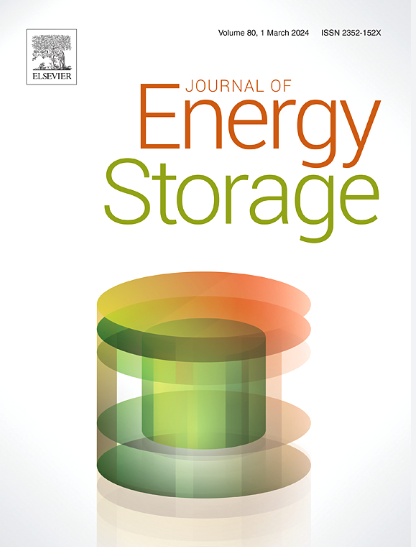在锌基器件中具有优异电化学性能的囊状多孔碳:从沥青和木材前体中提取
IF 8.9
2区 工程技术
Q1 ENERGY & FUELS
引用次数: 0
摘要
沥青已成为超级电容器、锌离子电容器(ZICs)和锌碘电池(ZIOBs)等电化学电极中多孔碳的杰出前体之一。然而,由于沥青前驱体的共轭特性,其化学反应性令人担忧。幸运的是,生物质具有高挥发性和丰富的o基团,非常适合用于改性化学惰性较强的沥青。因此,在之前一步氧化活化的基础上,以木材改性石油沥青(PA)为原料,在KHC2O4-KBr熔盐的支持下,制备了多孔碳。檀香木(SA)修饰的典型样品PA/SAC具有较高的比表面积(1339.1 m2 g−1)、独特的囊泡结构、丰富的缺陷和多杂原子,表现出优异的电化学性能。在三电极系统中,PA/SAC具有431.2 F g−1 (0.5 a g−1)的高比电容。其次,作为ZIC阴极,还可以实现234.9 mAh g−1的高容量和187.9 Wh kg−1的高能量密度。更重要的是,将PA/SAC与碘混合得到的配合物PA/SAC@I在ZIOB阴极中也获得了273.0 mAh g−1的高容量。总之,这项工作完成了廉价沥青和生物质的利用,同时激发了电化学储能业务。本文章由计算机程序翻译,如有差异,请以英文原文为准。

Vesicular porous carbon with outstanding electrochemical performances in Zn-based devices: Extracted from asphalt and wood precursors
Asphalt has emerged as one of the outstanding precursors of porous carbon in electrochemical electrodes, e.g., supercapacitors, zinc ion capacitors (ZICs), and zinc iodine batteries (ZIOBs). However, the chemical reactivity of asphalt precursors is a concern due to their conjugated character. Fortunately, biomass, with its high volatile content and abundance of O-groups, is well-appropriate for modifying the more chemically inert asphalt. Accordingly, based on the previous one-step oxidation activation, the porous carbons have been obtained by wood-modified petroleum asphalt (PA) and with the support of KHC2O4-KBr molten salts. The typical sample, PA/SAC modified by sandalwood (SA), possesses a high specific surface area (1339.1 m2 g−1), a unique vesicular structure, abundant defects, and multiple heteroatoms, showing excellent electrochemical properties. In the three-electrode system, PA/SAC possesses a high specific capacitance of 431.2 F g−1 (0.5 A g−1). Next, as a ZIC cathode, a high capacity of 234.9 mAh g−1 and a high energy density of 187.9 Wh kg−1 can also be achieved. More importantly, the complex PA/SAC@I obtained by mixing PA/SAC with iodine also achieved a high capacity of 273.0 mAh g−1 in the cathode of ZIOB. In conclusion, this work accomplishes the utilization of cheap asphalt and biomass while inspiring the electrochemical energy storage business.
求助全文
通过发布文献求助,成功后即可免费获取论文全文。
去求助
来源期刊

Journal of energy storage
Energy-Renewable Energy, Sustainability and the Environment
CiteScore
11.80
自引率
24.50%
发文量
2262
审稿时长
69 days
期刊介绍:
Journal of energy storage focusses on all aspects of energy storage, in particular systems integration, electric grid integration, modelling and analysis, novel energy storage technologies, sizing and management strategies, business models for operation of storage systems and energy storage developments worldwide.
 求助内容:
求助内容: 应助结果提醒方式:
应助结果提醒方式:


